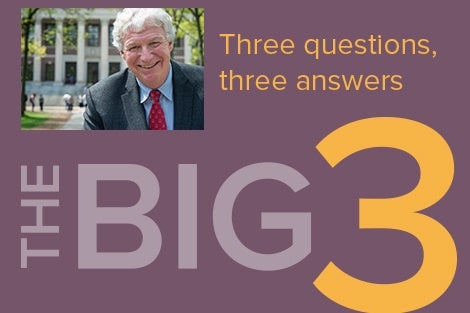August 31, 2017—Tropical storm Harvey has wreaked devastation on Houston, Texas since making landfall as a hurricane on August 26. Richard Serino, distinguished visiting fellow at the National Preparedness Leadership Initiative (NPLI) at Harvard T.H. Chan School of Public Health and Harvard Kennedy School and former deputy administrator of the Federal Emergency Management Agency (FEMA), spoke about the response so far and the long recovery ahead in Texas and Louisiana.
Can you assess the response to Harvey so far? What has been working well, and what are some of the challenges faced by emergency management agencies?
Hundreds of thousands of people are involved in the response from all across the nation. One of the things that has been working well has been the coordination—the communication—between the federal, state, and local levels in preparation for Harvey making landfall, and also the coordination in the initial rescue portion of the response.
One of the biggest challenges is that the response is very much still in life-saving mode. There are still a number of people that are trapped in homes that need to be brought to safety. Anybody that’s in a flooded home, that’s trapped, and they have serious medical conditions, those are the ones that are going to be triaged and prioritized first. One of the great things that we have seen, along with the federal, state, and the local assistance, is a lot of neighbors helping neighbors, for example, people using their own boats to rescue people.
Once the rescue stage is over the focus will shift to providing shelter, food, and water for the tens of thousands of people who have lost their homes. There is not going to be a quick resolution to this. This is going to take not weeks, not months, but years for those affected to recover from this disaster.
What has made Harvey so destructive? Was Houston well-prepared for a storm of this magnitude?
I think it’s multifaceted. These types of emergencies are very complex disasters. With Harvey, it’s the first time that we’ve had a major hurricane hit the United States in 12 years. And then on top of that, it was a large major urban area that has over 6 million people in it, that has received, as of recently, at least 49 inches of rain—and some places have seen more than 50 inches. That’s totally unprecedented.
It’s really too early to look at any sort of after-action [assessment]. But Houston has had a number of flooding incidents over the last number of years. They have a lot of experience. When I was the deputy administrator of FEMA, we went down there and looked at some of the mitigation tools they had developed, both for the city and with some of the hospitals, and the tools they had in place were some of the best in the country. So they’ve been preparing for flooding for quite a while. And the Texas State Emergency Management Director, Nim Kidd, is somebody who is very experienced, very knowledgeable. And a combination of those tools and the drills they’ve had have helped.
The storm has reached Louisiana which was devastated by Hurricane Katrina in 2005. Is that state prepared for Harvey?
Since Katrina, there have been a lot of lessons learned. One of the things we focus on at the NPLI is the importance of connectivity, and the coordination between the federal, the state, the local agencies—and communication with the public—has improved since then. Last August Louisiana experienced devastating flooding in 20 parishes, so they should be prepared. There have been some issues in New Orleans with some of the [drainage] pumps that they’re trying to get rectified. It’s going to be a challenge if a lot of rain falls on New Orleans. It would be a challenge anywhere. And as much as you practice, as much as you drill, we call these disasters for a reason.
This is not going to be an easy fix. This is not something that people are going to be able to just say, ‘Oh, tomorrow, we’re going to go back to normal.’ There’s going to be a new normal in Texas. And hopefully not, but there could be a new normal in Louisiana, as well.
